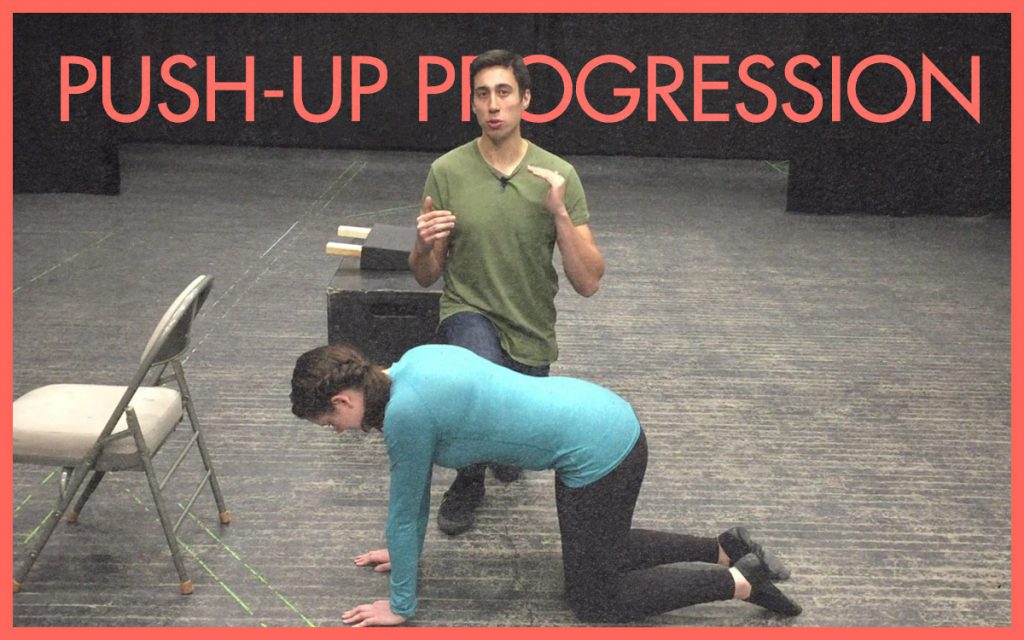
Push-Up Progression For Female Beginners
In this push-up guide, I outline a few reasons why push-ups are so hard for women, how to start doing push-ups as a female beginner, what the best progression is, how to correct any mistakes you might be making.
The idea for this article came up one day when I was heading to the bathroom during a break in my university class. I heard music coming from one of the dance studios down the hall. It sounded like intense workout music, so there was a one hundred percent chance I was going to explore. Looking through the door, I was exposed to a group of people doing push-ups.
Since it was a musical theatre class, it was mostly made up of women. Everyone in this class was doing their best to execute the push-up properly. However, they were struggling.
It makes sense that they were struggling. Hardly anyone is capable of doing a classic push-up properly on their first try, so if you’ve never been shown proper progressions, it is almost guaranteed that you will ingrain bad habits and then even with plenty of practice, be doing them improperly for a long time to come.
I believe the push-up is essential because if you can do it correctly off the ground, it shows you have a great connectedness in your body. The push-up requires solid upper body strength, but more importantly, it’ll only look good if you can hold your entire body in a strong position.
That is not easy, but you can learn how to do it.
Push-Up Progression For Women
Do Push-Ups On A Raised Surface
The best way to learn push-ups is to start by doing them on an incline, gradually working your way down to the floor. Here’s a tutorial video where Marco teaches how to do and progress the push-up:
Rib Positioning & Bracing During A Push-Up
Since the push-up is an upper-body exercise, it makes sense that you need a solid upper body to execute it properly. Well, the foundation of your upper body starts with your rib cage, then your shoulder blades, then your arms. If your rib cage is in the wrong position, it can mess up the rest of the sequence. This is why starting with a more advanced variation can lead to so much struggle—everything collapses.
Complete Women’s Push-Ups Walkthrough Video
While there are a few different styles of push-ups out there, what is right for you may be different from what is right for another. I usually recommend a semblance of a straight line from your head to your toes, with the main movement coming from your shoulders and elbows. Keep in mind that everyone will have different postures based on how they’ve grown up. There is no need to try to be perfect, only to start with the right progression and to make sure it feels good while you do it. If your technique looks like that of the women in the video, then you’re okay in my books.
Check out the video below to get a feel for the rib and pelvic drills as well as how I teach the push-up. Take note that each woman has a slightly different way of doing it. They are all new to lifting.
In this video, the girls share their struggles with the push-ups:
Women’s Push-Up Workout Routine
Push-ups are a big compound exercise, so they usually do well as one of the first exercises in our workouts. A workout might begin by alternating between squats and push-ups, for example.
Here are two examples, one if you are doing push-ups in your workout and one if you’re trying to rapidly improve your ability to do push-ups.
Example 1—Adding Push-Ups To A Workout
In this scenario, Kate trains twice a week and is using the push-up as her main upper body “push” exercise to improve core and upper body strength and size. She is a new lifter with a pelvic and rib position of someone who has a more fatigued posture. She is doing a simple workout plan that covers the basics.
- Warm Up – All Four Reach, 90/90 hip lift.
- A1. Goblet Squat 3 x 10
- A2. Push Ups 3 x 10,10, As many reps as possible, stopping before her form becomes forced.
- B1. Romanian Deadlift 3 x 10
- B2. Seated Row 3 x 10
- C1. Farmer Walks 2 x 100 yards
- C2. Push Up Plank 2 x 3 full breath cycles
I like to progress the push-up height when someone can do 20 push-ups in a row at a certain height. That way, when we lower the height, they’re more likely to be able to do at least 5-8 reps at least.
Example 2: Push-Up Sets & Reps
Faith really wants to improve her push-ups fast because she’s passionate about feeling good. Here is her plan:
- All Four Reach, 90/90 Hip Lift then
- 3 sets of push-ups done 3x throughout the workweek (Monday-Friday)
- Set 1 – Easier warm up set done for 20 reps – choose a height you could get 30 reps at and take your time through these reps, breathe through them, take pauses at different heights, make your technique great.
- Set 2 – A challenging set of 15 reps – Choose a height you can only do 20 reps at
- Set 3 – A challenging set of 5-12 reps – this should be quite challenging, yet keep your technique perfect – leave 2-3 reps in the tank since you will be doing these every day.
Why Are Push-Ups Important For Women To Learn?
The push-up is one of the best exercises for gaining upper-body strength and muscle size. It’s famous for developing the chest, but it also trains the fronts of the shoulders (front deltoids), the back of the arms ( triceps), our six-pack abs (rectus abdominus), and a number of smaller muscles, such as our serratus anterior. As a result, push-ups increase women’s upper-body strength, can help to fix their posture, improve the appearance of their arms, and, by developing the chest, can even make breasts look fuller and firmer.
Of all the exercises that they do, only the squat or Romanian Deadlift can rival the push-up for their ability to build overall muscle mass and general strength. This earns it a spot as one of the foundational exercises that everyone should be doing, including women, but most especially skinny women who are trying to gain muscle size and strength.
Why Are Push-Ups So Hard For Women?
Men genetically have more upper body muscle than women. Men love developing big arms, chests and shoulder muscles. It is no surprise that we always hear about people like Mike Tyson and Mohammed Ali doing hundreds of push-ups a day. It is not just them: most men have gone through a phase in their life when they were doing many push-ups (however secretly) on their bedroom floor.
In talking with women, they don’t have the same relationship with push-ups. Mainstream media pumps images into your brain that a nice butt and a flat stomach are the only things you need. And while those things can be healthy and help you develop the body you are after, being able to do a proper push-up from the ground is just as important.
While squats are more famous for women, push-ups will do as much for your physique, as well as improving your squat.
Let me explain: learning how to do a proper push-up involves learning how to hold your hips in the best position to develop your glutes, and it develops your upper body to be able to hold more weight when squatting. Push-ups also decrease your chances of getting injured, and they improve your day-to-day abilities.
Being able to do 5–10 clean, proper push-ups off the ground means you have a base level of core and shoulder stability and wrist and shoulder mobility. You will notice that your upper body looks quite a lot better. That strength will then seep into your other lifts, improving the results that you get out of all your lifting.
What Are “Girl” Push-Ups?
Push-ups are great if you learn how to do them properly from a young age. They require great core strength, shoulder strength, and shoulder and rib mobility. You know the old saying: “if you don’t use it, you lose it”? Well, that happens. Bodies adapt differently to what an individual does. So the longer you’ve gone without doing a push-up, the harder it gets.
Because of the steep learning curve to push-ups from the floor, most women have been taught “girl” push-ups at some point in their lives. While I am actually a big fan of the exercise, it all depends on how you use it. Making someone do girl push-ups without first showing them how to do a classic push-up will extinguish further learning.
Girl or not, you will do better by learning the classic push-up form but using a raised surface. And make no mistake, you will soon be strong enough to do it from the floor.
Summary
1. Choose the right level to start at.
The right level is one that allows you to do the perfect push-up technique for 90% of your reps. If you find you’re moving in places other than the shoulders, elbows and ribs, you’ll want to make it easier. Raise the surface, and stay there until you can do 20 reps with good form, then try lowering it again.
While I use more volume when learning the push-up, once you can do 10 from the ground, you can program them however you feel like. Get your ribs moving, get your pelvis moving, start at the right place and challenge yourself!
2. Challenge yourself.
If you start at the right height, the first couple sets should be easier so that you can get a feel for the technique and develop confidence with the exercise. That will help ingrain good, natural technique. Once you’ve achieved that feeling, it’s time to give yourself a challenge that you suspect you can overcome. So if your first two sets feel great, lower the height of the surface and do as many push-ups as you can, stopping before you revert to bad habits and your form collapses.
Push-ups are a great exercise to link the upper and lower body as well as make you a more useful and safe human. It will also dramatically improve the appearance of your entire upper body: arms, shoulders, chest, and posture.
What Next?
If you liked this article, you’d love our muscle-building newsletter. We’ll keep you up to date on all the latest muscle-building information for women. Or, if you want us to walk you through the process of building muscle, including teaching you the lifts, giving you a full workout program, a complete diet guide, a recipe book, and online coaching, check out our Bony to Bombshell Program.
Marco Walker-Ng is the co-founder and strength coach of Outlift, Bony to Beastly, and Bony to Bombshell. He's also a certified trainer (PTS) and nutrition coach (PN) with a Bachelor's degree in Health Sciences (BHSc) from the University of Ottawa. His specialty is helping people build muscle to improve their strength and performance, with clients including college, professional, and Olympic athletes.


